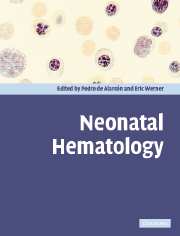Book contents
- Frontmatter
- Contents
- List of contributors
- Foreword
- Preface
- 1 Neonatal hematology: a historical overview
- 2 Disorders of the fetomaternal unit
- 3 Erythropoiesis, red cells, and the approach to anemia
- 4 Anemia of prematurity and indications for erythropoietin therapy
- 5 Hypoplastic anemia
- 6 Hemolytic disease of the fetus and newborn
- 7 Neonatal hemolysis
- 8 Neonatal screening for hemoglobinopathies
- 9 Polycythemia and hyperviscosity in the newborn
- 10 Newborn platelet disorders
- 11 Neutrophil function and disorders of neutrophils in the newborn
- 12 Immunodeficiency diseases of the neonate
- 13 Hemostatic abnormalities
- 14 Transfusion practices
- 15 Umbilical-cord stem-cell transplantation
- 16 Neonatal oncology
- 17 Normal values and laboratory methods
- Index
- References
16 - Neonatal oncology
Published online by Cambridge University Press: 10 August 2009
- Frontmatter
- Contents
- List of contributors
- Foreword
- Preface
- 1 Neonatal hematology: a historical overview
- 2 Disorders of the fetomaternal unit
- 3 Erythropoiesis, red cells, and the approach to anemia
- 4 Anemia of prematurity and indications for erythropoietin therapy
- 5 Hypoplastic anemia
- 6 Hemolytic disease of the fetus and newborn
- 7 Neonatal hemolysis
- 8 Neonatal screening for hemoglobinopathies
- 9 Polycythemia and hyperviscosity in the newborn
- 10 Newborn platelet disorders
- 11 Neutrophil function and disorders of neutrophils in the newborn
- 12 Immunodeficiency diseases of the neonate
- 13 Hemostatic abnormalities
- 14 Transfusion practices
- 15 Umbilical-cord stem-cell transplantation
- 16 Neonatal oncology
- 17 Normal values and laboratory methods
- Index
- References
Summary
Oncology
Malignancies occurring in the newborn have some unique features that distinguish them from tumors occurring later in childhood. Neonatal tumors generally are not histologically distinct from those occurring later, but their incidence is different. Perinatal cancers also can vary in their clinical presentation, biology, course, and response to treatment. Some tumors of infancy are associated with inherited syndromes and chromosomal/gene abnormalities. This chapter will review malignant tumors that occur in the newborn, focusing on features that differ from tumors occurring later in childhood.
Epidemiology
Cancer in the newborn (defined for purposes of this chapter as cancer diagnosed before one month of age) is a rare event. Data from the Third National Cancer Survey (1969–71) reported an incidence of 3.65 cases diagnosed before 29 days of life per 100000 live births [1]. Other population-based studies have yielded numbers within the same range (1.88–2.98/100000 and 2.27/100000) [2, 3]. More cancers are diagnosed in the first year of life than in any other year (up to age 18 years) according to data from the Surveillance, Epidemiology, and End Results program from 1976 to 1984 and from 1986 to 1994, with an incidence of 23.3/100000/year [4]. Assuming an equal distribution over each four-week period, this translates to 1.8 cases/100000/four-week period. It does not appear that neonatal cancers account for a disproportionate number of tumors diagnosed before one year of age.
The distribution of types of malignancies in the neonatal period is different from that found in later childhood.
- Type
- Chapter
- Information
- Neonatal Hematology , pp. 385 - 405Publisher: Cambridge University PressPrint publication year: 2005



